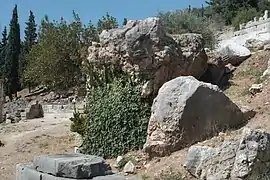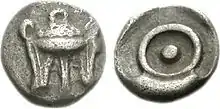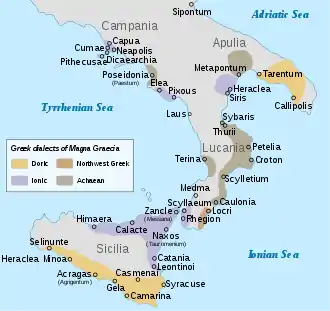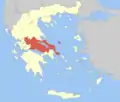Delphi
Delphi (/ˈdɛlfaɪ, ˈdɛlfi/; Greek: Δελφοί [ðelˈfi]),[lower-alpha 1] in legend previously called Pytho (Πυθώ), in ancient times was a sacred precinct that served as the seat of Pythia, the major oracle who was consulted about important decisions throughout the ancient classical world. The oracle was international in character and also fostered sentiments of Greek nationality, even though the nation of Greece was centuries away from realization. The ancient Greeks considered the centre of the world to be in Delphi, marked by the stone monument known as the omphalos (navel). The sacred precinct was in the region of Phocis, but its management had been taken away from the Phocians, who were trying to extort money from its visitors, and had been placed in the hands of an amphictyony, or committee of persons chosen mainly from Central Greece. According to Suda, the Delphi took its name from the Delphyne, the dragon who lived there and was killed by the god Apollo (in other accounts the serpent was called Python).[4][5]
Δελφοί | |
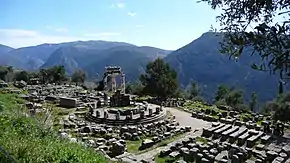 The Athena temple complex, including the Delphic Tholos, photographed from Route 48 just above it. The background is the Pleistos River Valley. The view is looking upstream. | |
 Delphi Shown within Greece | |
| Location | Phocis, Greece |
|---|---|
| Coordinates | 38°28′56″N 22°30′05″E |
| Type | Ruins of an ancient sacred precinct |
| Height | Top of a scarp 500 metres (1,600 ft) maximum off the valley floor |
| History | |
| Cultures | Ancient Greece |
| Site notes | |
| Archaeologists | French School at Athens |
| Ownership | Hellenic Republic |
| Management | Ministry of Culture and Sports |
| Public access | Accessible for a fee |
| Website | E. Partida (2012). "Delphi". Odysseus. Ministry of Culture and Sports, Hellenic Republic. |
| Official name | Archaeological Site of Delphi |
| Type | Cultural |
| Criteria | i, ii, iii, iv and vi |
| Designated | 1987 (12th session) |
| Reference no. | 393 |
| State Party | Greece |
| Region | Europe |
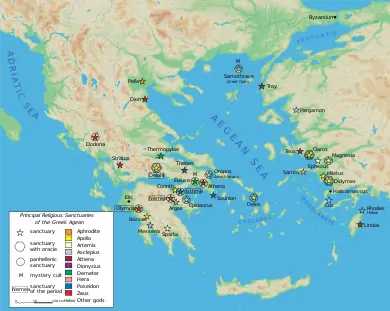
The sacred precinct occupies a delineated region on the south-western slope of Mount Parnassus. It is now an extensive archaeological site. Adjacent to the sacred precinct is a small modern town of the same name. The precinct is recognised by UNESCO as a World Heritage Site in having had a great influence in the ancient world, as evidenced by the various monuments built there by most of the important ancient Greek city-states, demonstrating their fundamental Hellenic unity. It would be impossible to remove the influence of the Delphic oracle from the written history of the times.
Geography of the sacred precinct

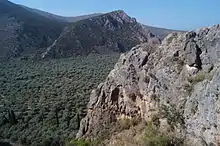
The two Delphis, old and new, are located on Greek National Road 48 between Amfissa in the west and Livadeia, capital of Voiotia, in the east. The road follows the northern slope of a pass between Mount Parnassus on the north and the mountains of the Desfina Peninsula on the south. The peninsula, triangular in shape, juts into the Gulf of Corinth.
The pass is entirely one river valley, that of the river Pleistos, running from east to west, forming a natural boundary across the north of the Desfina Peninsula, and providing an easy route across it. Today, because of human use of the water, the river is not much of a stream. Being intermittent along its entire length it is scarcely visible from above.[lower-alpha 2]
On the east side the valley joins the north-south valley leading from Davleia to Distomo, both good-sized towns. South of Distomo the valley intersects the Bay of Antikyra, which offers no port at that location. The site is known as Paralia Distomou, "the beach of Distomo," and is a real estate development. Antikyra, the major port of Phocis, is a little down the coast of the peninsula.
On the west side the valley joins the north-south valley between Amfissa and Itea. The valley dead-ends at Amphissa. This city is more important today because a route to the Aegean side of Greece has been pushed through the mountain passes. These now strategic locations were the scenes of heavy fighting and reprisals during World War Two.
On the north side of the valley junction a spur of Parnassus looming over the valley made narrower by it is the site of ancient Krisa, which once was the ruling power of the entire valley system. Both Amphissa and Krissa are mentioned in the Iliad's Catalogue of Ships.[6] It was a Mycenaean stronghold. Archaeological dates of the valley go back to the Early Helladic. Krisa itself is Middle Helladic.[7] These early dates are comparable to the earliest dates at Delphi, suggesting Delphi was appropriated and transformed by Phocians from ancient Krisa. It is believed that the ruins of Kirra, now part of the port of Itea, were the port of Krisa of the same name as it, and that etymologically Kirra comes from Krisa.[8]
In Mycenaean times Krissa was a major Greek land and sea power, perhaps one of the first in Greece, if the Early Helladic date of Kirra is to be believed.[9] The ancient sources indicate that the previous name of the Gulf of Corinth was the "Krisaean Gulf."[10] Like Krisa, Corinth was a Dorian state, and Gulf of Corinth was a Dorian lake, so to speak, especially since the migration of Dorians into the Peloponnesus starting about 1000 BC. Krisa's power was broken finally by the recovered Aeolic and Attic-Ionic speaking states of southern Greece over the issue of access to Delphi. Control of it was assumed by the Amphictyonic League, an organization of states with an interest in Delphi, in the early classical period. Krisa was destroyed for its arrogance. The gulf was given Corinth's name. Corinth by then was like the Ionic states: ornate and innovative, not like the spartan style of the Doric.
The Pleistos, or Plistos, enters the Gulf of Itea undramatically through a culvert of the coastal road on the east side of Cirra. A stream a few inches deep leaves the culvert to cross a small delta, geologically of antique origin. This stream is alternately labelled the Pleistos or the Cirra River. On the other side of the road it comes from a wetland passing by St. John's Church. The wetland originates further north from a ravine in Mount Cirphis, but it does not receive any waters above ground from the flow of Pleistos.
A few yards to the west of the culvert is another culvert under the same road, but without a delta. Its water comes from an apparent ditch beside the Itea Peripheral Road. Northward this ditch leaves the road and becomes a controlled channel through the olive groves. Along it are private farmhouses and footbridges. The channel is continuous with the stream in the Pleistos Valley. The visible bed is usually empty. If Pleistos means "full" as some say it does, the use must be an irony, as the river is usually "empty."
Apparently the hydrologic channels were altered in the management of the groves. They cover the entire non-urban areas of the valley system and are called locally "the sea of olives." The stream with the braided delta must represent the more ancient stream, the original Pleistos. During the reconfiguration of the hydrology, the Pleistos was disconnected from its wetlands and forced to irrigate olive trees. The climate is semi-arid. The wetlands then became the Cirra. A similar nomenclature discrepancy exists on the west side of the valley. The Skitsa River erodes the Amfissa Valley and then courses in a straight, controlled channel to the gulf at Itea, irrigating the west side of the valley. The sources say that it also was formerly named the Plistos, implying that the same Plistos river drained both valleys before different channels were dredged.
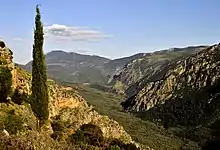
The upper Pleistos follows the base of Mount Cirphis. There is a gradient across the valley, the high side being on the north. The low side is called by some "the Pleistos ravine." It is joined by a single stream resulting from the merger of the Delphi springs, but does not originate there. The source is a ravine under Arachova, a mountain city on Route 48. The upper Pleistos and its valley are protected: no industrial artefacts are to be seen from Delphi (for example high voltage power lines and the like are routed so as to be invisible from the area of the sanctuary). The stream has been left in its original bed, visible as tracks of bare limestone. A hiking trail on the footprint of the original access road begins on the docks at Cirra, procedes straight up the valley to the upper Pleistos, follows it to the springs, and ascends their stream to the Castalian Spring. The hike takes 3-4 hours. Most visitors take the bus along Route 48. The road at the spring includes a bus park.
Geology of the Pleistos valley system
The Pleistos Valley is an outcome of two main standard movements of the crust: the orogeny of Parnassus and the other mountains of Greece, termed the Hellenides, and back-arc extension, a southward-directed movement of the Peloponnesus and Aegean islands.
Hellenic orogeny
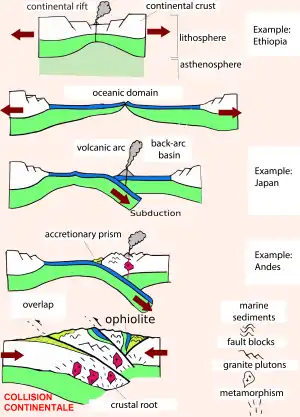
Orogeny today is considered the result of plate collision. In the theory of continental drift, the surface of the Earth is divided by mid-ocean ridges and oceanic trenches into plates, or "tectonic plates,"[lower-alpha 3] which "drift" over the Earth and collide, as though the dense base rock were an ocean and the lighter plates with continents upon them were adrift.
The idea of rock drifting over rock impeded the acceptance of continental drift, proposed by Alfred Wegener in 1912, until the data gethered in the International Geophysical Year of 1957-58 confirmed it. The apparent physical problem was reconciled through a study of the solid-state properties of rock. It is deformable, and the hotter it gets, the more it deforms. Over geologic time the sum of very small deformations under steady pressure gives the impression of a flow.
The forces deforming the continental plates across the globe are found in the Earth's mantle, which has a liquid inner portion termed the asthenosphere and an outer, solid but deformable portion, the lithosphere. The liquid arranges itself by density, heaviest on the bottom, but there is a rising temperature gradient from outer to inner. The hot rock becoming less dense rises in plumes. When one reaches the surface it spreads out, forcing the lithosphere apart. New plate is extruded as lava fills the gap. On the other side of the plate the now cooler material dives down, or is subducted, beneath the adjacent plate.[11] Orogenies, therefore, are a result of either divergent boundaries, in which divergence thins and weakens the lithosphere allowing magma to escape, building a chain of volcanoes (Ring of Fire or mid-ocean ridge configuration), or convergent boundaries. In the latter one plate is subducted under another, raising its margin into a mountain chain.
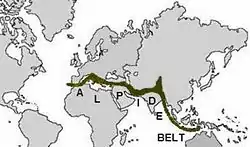
The Hellenic orogeny is part of a 15,000 km (9,300 mi) zone of convergence called the Alpide belt. If one can imagine the Eurasian Plate as an anvil, a number of other plates hammer against it from the south. The African plate moving northward closes Tethys ocean, the much vaster ancestress of the Mediterranean Sea, and raises the Pyrenees, the Alps, and the mountains of the Balkans. Further east, the Arabian Plate and the Indian Plate raise the Caucasus Mountains and Himalayas. The zone extends as far as Java and Sumatra.[12][lower-alpha 4]
That part of the zone relevant to Greece, or Hellas, is the alpine orogeny, accounting for the Alps, the Dinaric Alps, and their continuation into Greece.[lower-alpha 5] The terms, Dinarides and Hellenides, are in use in geology. The -ides suffix was the innovation of Eduard Suess, author of Das Antlitz der Erde ("The Face of the Earth"), and contemporary of Wegener. The prevalent view of orogeny at the time was the geosynclinal. By the late 19th century movements of the crust during earthquakes had been systematized into tangential and radial with respect to the Earth.[13] Geosynclinal theorists asserted that the cause of the movements was the cooling and contracting of the Earth, causing major wrinkles in the surface.[lower-alpha 6]
A wrinkle is a syncline, in which the sides "lean together," joining at the bottom, flanked by anticlines, in which they "lean apart." James Dana and James Hall proposed the prefix "geo-." The simplest ideal geosyncline, or geosynclinal, is an original central, or "inner," depression, flanked by "outer" geanticlines on the margins. The latter erode into the center, creating a mass that floats upward by isostasy. It is the "hinterland," while the margins are the "forelands." They may come into modern times as plains, foredeeps, or additional ridges.[14][lower-alpha 7]
By his own admission, Suess, originally an enthusiastic geosynclinist when he began his work, grew increasingly dissatisfied over the fact that the theory did not take vertical movements, or subsidences, into consideration, and dropped the use of the term in later volumes. He kept "syncline" provided it meant wrinkles from any source.[15] This change in view left him groping in the final volume of his work for the nature of the features he was defining to be in the Earth's face. His conclusion was that they are "long, continuous systems of folds which form the mountain chains of the Earth." The chains are arc-shaped, parallel ridges, which seem to have descended outward along the radius of curvature. They must have the same fold structure, which would be revealed by reconstructed cross-section. They must have the same plan revealed by the "trend-lines," one line being reconstructed from the strike lines of the ridges.[16] Having innovated the concept of systems of folds, to avoid having to list every range in a system, Suess devised a naming method for a system by suffixing -ides to the name of a major range in it: Alps in the system of Alpides. Moreover, systems could contain subsidiary systems. Geology adopted his method and most of his names, even after the change to continental drift.[lower-alpha 8]
Suess' account of the Mediterranean begins with the "collapse"[lower-alpha 9] of a zone across a Mesozoic supercontinent, Pangaea. The zone stretched from the Pacific to the Atlantic, dividing Pangaea into two forelands, Eurasia and Gondwana Land.[lower-alpha 10] Suess named the resulting sea Tethys, reusing a local name. All of Tethys was now a syncline. It received sediments from the forelands until at last they floated upward to become roughly parallel mountain chains striking in an E-W direction (with local variants). Suess needed a word for the chains. He named them collectively after one of the chief ranges, the Altai. The Altaides were all the chains across the entire band, the first of Suess's "-ides" units.[18]
Pleistos rift valley
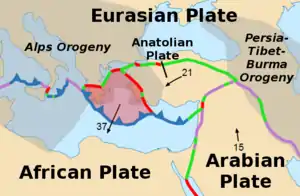
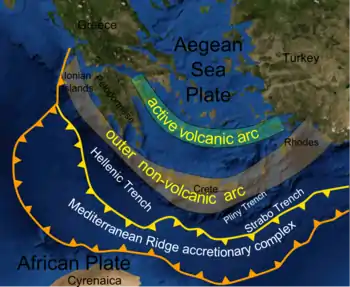
The Mediterranean is the remnant of the geologically ancient Tethys Sea being closed by the northward movement of the African Plate against the Eurasian Plate. The line of subduction of Africa under Eurasia runs in a general E-W direction through the Mediterranean. The southern margin of Eurasia rises over the subduction to become the mountains of the Alpide Zone as though they were folded up by compression, and to some extent they are. The subducted plate exerts a pressure on the overriding plate normal to the plane of contact.
One should therefore expect to find a tangential compression on the margin of the overriding plate, but this is not entirely the case. The margin is being extended out behind the arc of the raised mountains ("back-arc extension" meaning "in back of the arc"), and this extension, or stretching out, causes faults of the normal type. One of these is the Corinth Rift, which has opened across the NE-SW striking outer Hellenides, dividing them into the mountains of Central Greece and the mountains of the Peloponnesus.
The singular nouns, "Corinth Rift," "Eurasian Plate," and other words of vague geologic referents, do not refer to one object but are more like collective plurals, such as Suess' -ides words. The original naive assumption of singularity did not fit the apparent drift movements of land masses in the Mediterranean. Further study, which is still ongoing, has uncovered complexities that help to understand how the drift theory can apply to the closure of Tethys, despite the many contradictions. More recently the back-arc extension theory has filled in much of the gap.
The extension occurs as one stage in a chronological sequence of geologic stages. First, the plates must collide and one be subducted under the other at the line of collision. This line is marked by a trench, or foredeep, as the subducted plate dives down. Second, the margin of the overriding, or upper, plate, must be elevated and wrinkled into an arc, which may not be initially an arc. These stages in the Eastern Mediterranean were described in the previous section.
The third stage, extension, may or may not occur depending on the geologic conditions: the strike, the dip, the viscosity, the coefficient of friction, and so on. When it does occur, the arc moves in a direction opposite the subduction ("back"), becoming arc-shaped if it is not already, thinning the margin of the overriding plate, creating a volcanic arc behind it, as the magma escapes from the thinner crust, and opening a normal fault zone behind that. There is no generally accepted explanation of back-arc motion.[19][lower-alpha 11] Several theories have been proposed; in the literature the one being presented is usually touted as "the explanation."
The Eastern Mediterranean is currently in the 3rd stage described above; that is, back-arc extension is required to explain its major features. The results of the Alpine Orogeny are still in place in Northern Greece, but to the south, extension has created two microplates, or subplates, divided from the Eurasianan Plate on the north by divergent borders or normal faults: the Aegean and the Anatolian.
Topography of the Pleistos valley
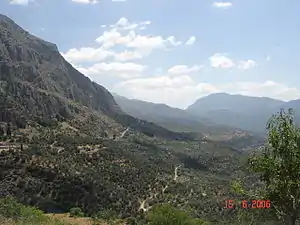
The Pleistos valley is not much of a rift valley. The rift is relatively recent, the separation is slight, and a scarp is still visible all the way from Amphissa to the head of the valley. It is not unmitigated, however. There are few places where the climber might have to ascend a thousand-foot cliff. Most of the scarp has been subject to extensive rockfalls and landslides, which have created a slope of scree up to about 50% of the scarp. The scree extends over the entire valley floor up to the Pleistos ravine. Slopes vary from very slight to up to 60°. The bare scarp varies from 60° to 90° and beyond, if there is an overhang. In general, the scree is on the footwall of the fault, but erosion has produced some overhangs.
There is no meander to speak of on the valley floor, and thus no plain, and but little agriculture. The rolling hills that have developed are suitable for dendroculture. There is also no room for any highway or any extensive structures. The surface is laced with dirt roads for access to the olive trees. Many of these ascend the scree. Delphi is not perched on a cliff; all the cliffs are above it. There is no problem ascending to Delphi or descending from it to tend to the trees. All builders, however, found it necessary to create terraces on which to place the structures. The archaeological site features multiple terraces with retaining walls. The Sacred Way must ascend to the terraces on ramps. Photographs from above showing the edges of the terraces are apt to be misleading. There is no drop-off. A grassy slope leads downward.
In modern times the access problem was solved by leveling the top of the scree and building a road there. The highway is good, two-lane, hard-top road, which gains or loses altitude in a few places by some hairpin legs. A highway fence lines the outside of the road. Many parking areas for viewing have been excavated into the scarp or placed on filled extensions to the width. The Sacred Precinct in particular has been provided with a large bus park. The road goes right through the middle of the site, creating an upper and a lower site. Most pictures, however, never show the road. They give the illusion of the scree merging directly to the bare scarp, which only happens at the top of the upper site.
Archaeology of the precinct
The end of Delphi
Most cursory accounts of Delphi include a phase they call the end of Delphi. After all, ruins are in evidence, so there must have been a time when the structures they represent were unruined. Many give the impression that the emperor's sheriff drove up the hill with a bulldozer and a wrecking ball, or a least an army of wreckers, and went back down the hill the same day having levelled the site, and that from then on it remained uninhabited. Although such a sudden event is possible with the equipment of modern times, it did not generally happen that way in ancient times, except in unusual cases, such as the fall of Carthage, when the Romans leveled the city and sowed the bare ground with salt so that nothing would grow there. Even so, the city was rebuilt. Such was never the case for Delphi. It transitioned from phase to phase. There may never have been a time when the site had no inhabitants or structures, and no one was interested in living there. It had the spring and the view.
The ruins in evidence date from the ancient classical period with some in the late antique period. In order to place them in evidence, the first excavators, the French School of Athens, had to clear away many tons of rubble. But that rubble contained the habitation levels of post-classical settlements, which were sacrificed in favor of the earlier ruins. The lack of this transitional material also gives the impression of a sudden ruination, which is false. History portrays Delphi as a very popular site. Once in a century or two it was burned by some interloper, and then promptly rebuilt better than before. After Hellenic society transitioned from pagan to Christian, Delphi remained just as popular as it had been. Still pagan, it often honored the Christian emperors, while they allowed it to stand. Both religions were practiced there side-by-side. Finally, however, use of the oracle fell off to such a degree that it could no longer be maintained. The other aspects went on: the games, the worship of Apollo in the temple. Regretfully the Christian emperors dealt with all the pagan sites as a loose end. Delphi transitioned to a secular site in which churches were built. Without the oracle, there was not much point in frequenting a high-altitude, out-of-the-way place. The population fell off to a small village.
The place had not ended, however. Archaeology and tourism infused it with a whole new life. It may well be frequented by just as many people as frequented it in classical days. It earns its own revenue. The geologic problems are just as bad as they were in ancient times: faults, slippery slopes, earthquakes, rockslides, runoff. As at all major archaeological sites, the effort to maintain the ruins rivals the original effort to maintain the structures.
The classical site had flourished because of its popularity. After the change of religion, popularity and frequentation fell off sharply. The oracle could no longer cover operating expenses. After a line of Christian emperors, Julian, reigning 361-363 (not long), rejecting Christianity in favor of neoplatonism, for which he is called Julian the Apostate, attempted to restore the prior religions, paganism and Judaism. He sent his physician to Delphi to rebuild the Temple of Apollo, and received an oracle for his efforts that "the speaking water has been silenced," which became known as "the last oracle" and is recorded by George Kedrenos.[20][lower-alpha 12]
Excavation
_(14792888433).jpg.webp)
The site was first briefly excavated in 1880 by Bernard Haussoullier (1852-1926) on behalf of the French School at Athens, of which he was a sometime member. The site was then occupied by the village of Kastri, about 100 houses, 200 people. Kastri ("fort") had been there since the destruction of the place by Theodosius I in 390. He probably left a fort to make sure it was not repopulated, except that the fort became the new village. They were mining the stone for re-use in their own buildings. British and French travellers visiting the site suspected it was ancient Delphi. Before a systematic excavation of the site could be undertaken, the village had to be relocated but the residents resisted.
The opportunity to relocate the village occurred when it was substantially damaged by an earthquake, with villagers offered a completely new village in exchange for the old site. In 1893 the French Archaeological School removed vast quantities of soil from numerous landslides to reveal both the major buildings and structures of the sanctuary of Apollo and of Athena Pronoia along with thousands of objects, inscriptions and sculptures.[21]
During the Great Excavation were discovered architectural members from a 5th-century Christian basilica, when Delphi was a bishopric. Other important Late Roman buildings are the Eastern Baths, the house with the peristyle, the Roman Agora, the large cistern usw. At the outskirts of the city there were located late Roman cemeteries.
To the southeast of the precinct of Apollo lay the so-called Southeastern Mansion, a building with a 65-meter-long façade, spread over four levels, with four triclinia and private baths. Large storage jars kept the provisions, whereas other pottery vessels and luxury items were discovered in the rooms. Among the finds stands out a tiny leopard made of mother of pearl, possibly of Sassanian origin, on display in the ground floor gallery of the Delphi Archaeological Museum. The mansion dates to the beginning of the 5th century and functioned as a private house until 580, later however it was transformed into a potters' workshop.[22] It is only then, in the beginning of the 6th century, that the city seems to decline: its size is reduced and its trade contacts seem to be drastically diminished. Local pottery production is produced in large quantities:[23] it is coarser and made of reddish clay, aiming at satisfying the needs of the inhabitants.
The Sacred Way remained the main street of the settlement, transformed, however, into a street with commercial and industrial use. Around the agora were built workshops as well as the only intra muros early Christian basilica. The domestic area spread mainly in the western part of the settlement. The houses were rather spacious and two large cisterns provided running water to them.[24]
Delphi Archaeological Museum
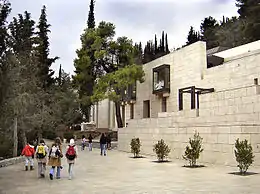
The Delphi Archaeological Museum is at the foot of the main archaeological complex, on the east side of the village, and on the north side of the main road. The museum houses artifacts associated with ancient Delphi, including the earliest known notation of a melody, the Charioteer of Delphi, Kleobis and Biton, golden treasures discovered beneath the Sacred Way, the Sphinx of Naxos, and fragments of reliefs from the Siphnian Treasury. Immediately adjacent to the exit is the inscription that mentions the Roman proconsul Gallio.
Entries to the museum and to the main complex are separate and chargeable. A reduced rate ticket gets entry to both. There is a small cafe, and a post office by the museum.
Architecture of the precinct
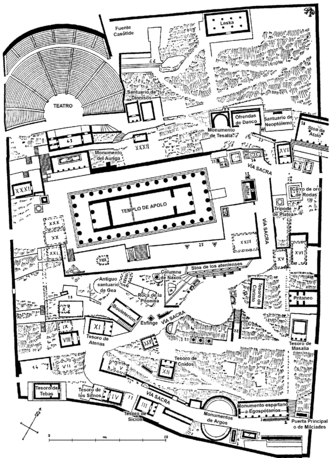
Most of the ruins that survive today date from the most intense period of activity at the site in the 6th century BC.[25]
Temple of Apollo
The ruins of the Temple of Delphi visible today date from the 4th century BC, and are of a peripteral Doric building. It was erected by Spintharus, Xenodoros, and Agathon on the remains of an earlier temple, dated to the 6th century BC which itself was erected on the site of a 7th-century BC construction attributed in legend to the architects Trophonios and Agamedes.[26]
Ancient tradition accounted for four temples that successively occupied the site before the 548/7 BC fire, following which the Alcmaeonids built a fifth. The poet Pindar celebrated the Alcmaeonids' temple in Pythian 7.8-9 and he also provided details of the third building (Paean 8. 65-75). Other details are given by Pausanias (10.5.9-13) and the Homeric Hymn to Apollo (294 ff.). The first temple was said to have been constructed out of olive branches from Tempe. The second was made by bees out of wax and wings but was miraculously carried off by a powerful wind and deposited among the Hyperboreans. The third, as described by Pindar, was created by the gods Hephaestus and Athena, but its architectural details included Siren-like figures or "Enchantresses", whose baneful songs eventually provoked the Olympian gods to bury the temple in the earth (according to Pausanias, it was destroyed by earthquake and fire). In Pindar's words (Paean 8.65-75, Bowra translation), addressed to the Muses:
- Muses, what was its fashion, shown
- By the skill in all arts
- Of the hands of Hephaestus and Athena?
- Of bronze the walls, and of bronze
- Stood the pillars beneath,
- But of gold were six Enchantresses
- Who sang above the eagle.
- But the sons of Cronus
- Opened the earth with a thunderbolt
- And hid the holiest of all things made.
- Away from their children
- And wives, when they hung
- Their lives on the honey-hearted words.
The fourth temple was said to have been constructed from stone by Trophonius and Agamedes.[27] However, a new theory gives a completely new explanation of the above myth of the four temples of Delphi.[28]
Treasuries
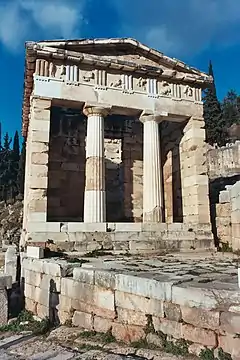
From the entrance of the upper site, continuing up the slope on the Sacred Way almost to the Temple of Apollo, are a large number of votive statues, and numerous so-called treasuries. These were built by many of the Greek city-states to commemorate victories and to thank the oracle for her advice, which was thought to have contributed to those victories. These buildings held the offerings made to Apollo; these were frequently a "tithe" or tenth of the spoils of a battle. The most impressive is the now-restored Athenian Treasury, built to commemorate their victory at the Battle of Marathon in 490 BC.
The Siphnian Treasury was dedicated by the city of Siphnos whose citizens gave a tithe of the yield from their silver mines until the mines came to an abrupt end when the sea flooded the workings.
One of the largest of the treasuries was that of Argos. Having built it in the late classical period, the Argives took great pride in establishing their place at Delphi amongst the other city-states. Completed in 380 BC, the treasury seems to draw inspiration mostly from the Temple of Hera located in the Argolis. However, recent analysis of the Archaic elements of the treasury suggest that its founding preceded this.
Other identifiable treasuries are those of the Sikyonians, the Boeotians and the Thebans.
 Boeotians
Boeotians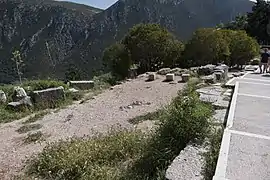 Cnidians
Cnidians_on_October_4%252C_2020.jpg.webp) Sicyonians
Sicyonians_on_October_4%252C_2020.jpg.webp) Siphnians
Siphnians
Altar of the Chians
Located in front of the Temple of Apollo, the main altar of the sanctuary was paid for and built by the people of Chios. It is dated to the 5th century BC by the inscription on its cornice. Made entirely of black marble, except for the base and cornice, the altar would have made a striking impression. It was restored in 1920.[21]
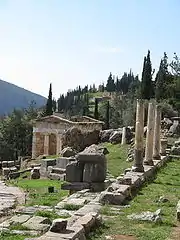
.jpg.webp)
Stoa of the Athenians
The stoa, or open-sided, covered porch, is placed in an approximately E-W alignment along the base of the polygonal wall retaining the terrace on which the Temple of Apollo sits. There is no archaeological suggestion of a connection to the temple. The stoa opened to the Sacred Way. The nearby presence of the Treasury of the Athenians suggests that this quarter of Delphi was used for Athenian business or politics, as stoas are generally found in market-places.
Although the architecture at Delphi is generally Doric, a plain style, in keeping with the Phocian traditions, which were Doric, the Athenians did not prefer the Doric. The stoa was built in their own preferred style, the Ionic order, the capitals of the columns being a sure indicator. In the Ionic order they are floral and ornate, although not as much as the Corinthian, which is in deficit there. The remaining porch structure contains seven fluted columns, unusually carved from single pieces of stone (most columns were constructed from a series of discs joined together). The inscription on the stylobate indicates that it was built by the Athenians after their naval victory over the Persians in 478 BC, to house their war trophies. At that time the Athenians and the Spartans were on the same side.
Sibyl rock
The Sibyl rock is a pulpit-like outcrop of rock between the Athenian Treasury and the Stoa of the Athenians upon the sacred way which leads up to the temple of Apollo in the archaeological area of Delphi. It is claimed to be where an ancient Sibyl pre-dating the Pythia of Apollo sat to deliver her prophecies. Or, the Pythia might have stood there, or an acolyte whose function was to deliver the final prophecy. The rock seems ideal for public speaking.
Theatre
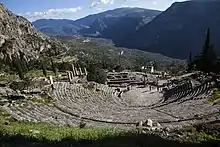
The ancient theatre at Delphi was built further up the hill from the Temple of Apollo giving spectators a view of the entire sanctuary and the valley below.[29] It was originally built in the 4th century BC but was remodeled on several occasions, particularly in 160/159 B.C. at the expenses of king Eumenes II of Pergamon and in 67 A.D. on the occasion of emperor Nero's visit.[30] The koilon (cavea) leans against the natural slope of the mountain whereas its eastern part overrides a little torrent that led the water of the fountain Cassotis right underneath the temple of Apollo. The orchestra was initially a full circle with a diameter measuring 7 meters. The rectangular scene building ended up in two arched openings, of which the foundations are preserved today. Access to the theatre was possible through the parodoi, i.e. the side corridors. On the support walls of the parodoi are engraved large numbers of manumission inscriptions recording fictitious sales of the slaves to the god. The koilon was divided horizontally in two zones via a corridor called diazoma. The lower zone had 27 rows of seats and the upper one only 8. Six radially arranged stairs divided the lower part of the koilon in seven tiers. The theatre could accommodate about 4,500 spectators.[31]
On the occasion of Nero's visit to Greece in 67 A.D. various alterations took place. The orchestra was paved and delimited by a parapet made of stone. The proscenium was replaced by a low pedestal, the pulpitum; its façade was decorated with scenes from Hercules' myth in relief. Further repairs and transformations took place in the 2nd century A.D. Pausanias mentions that these were carried out under the auspices of Herod Atticus. In antiquity, the theatre was used for the vocal and musical contests which formed part of the programme of the Pythian Games in the late Hellenistic and Roman period.[32] The theatre was abandoned when the sanctuary declined in Late Antiquity. After its excavation and initial restoration it hosted theatrical performances during the Delphic Festivals organized by A. Sikelianos and his wife, Eva Palmer, in 1927 and in 1930. It has recently been restored again as the serious landslides posed a grave threat for its stability for decades.[33][34]
Tholos

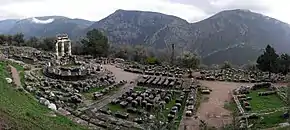
The Tholos at the sanctuary of Athena Pronoia (Ἀθηνᾶ Πρόνοια, "Athena of forethought") is a circular building that was constructed between 380 and 360 BC. It consisted of 20 Doric columns arranged with an exterior diameter of 14.76 meters, with 10 Corinthian columns in the interior.
The Tholos is located approximately a half a mile (800 m) from the main ruins at Delphi (at 38°28′49″N 22°30′28″E). Three of the Doric columns have been restored, making it the most popular site at Delphi for tourists to take photographs.
The architect of the "vaulted temple at Delphi" is named by Vitruvius, in De architectura Book VII, as Theodorus Phoceus (not Theodorus of Samos, whom Vitruvius names separately).[35]
Gymnasium
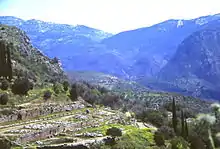
The gymnasium, which is half a mile away from the main sanctuary, was a series of buildings used by the youth of Delphi. The building consisted of two levels: a stoa on the upper level providing open space, and a palaestra, pool and baths on lower floor. These pools and baths were said to have magical powers, and imparted the ability to communicate to Apollo himself.[21]
Stadium
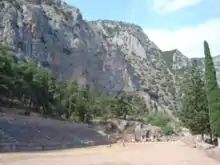
The stadium is located further up the hill, beyond the via sacra and the theatre. It was originally built in the 5th century BC but was altered in later centuries. The last major remodelling took place in the 2nd century AD under the patronage of Herodes Atticus when the stone seating was built and (arched) entrance. It could seat 6500 spectators and the track was 177 metres long and 25.5 metres wide.[36]
Hippodrome
It was at the Pythian games that prominent political leaders, such as Cleisthenes, tyrant of Sikyon, and Hieron, tyrant of Syracuse, competed with their chariots. The hippodrome where these events took place was referred to by Pindar,[37] and this monument was sought by archaeologists for over two centuries.
Its traces have recently been found at Gonia in the plain of Krisa in the place where the original stadium was sited.[38]
Polygonal wall
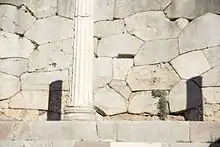
The retaining wall was built to support the terrace housing the construction of the second temple of Apollo in 548 BC. Its name is taken from the polygonal masonry of which it is constructed. At a later date, from 200 BC onwards, the stones were inscribed with the manumission contracts of slaves who were consecrated to Apollo. Approximately a thousand manumissions are recorded on the wall.[39]
Castalian spring
The sacred spring of Delphi lies in the ravine of the Phaedriades. The preserved remains of two monumental fountains that received the water from the spring date to the Archaic period and the Roman, with the latter cut into the rock.
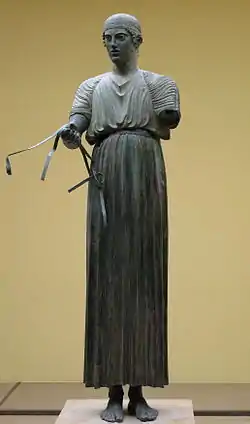
Athletic statues
Delphi is famous for its many preserved athletic statues. It is known that Olympia originally housed far more of these statues, but time brought ruin to many of them, leaving Delphi as the main site of athletic statues.[40] Kleobis and Biton, two brothers renowned for their strength, are modeled in two of the earliest known athletic statues at Delphi. The statues commemorate their feat of pulling their mother's cart several miles to the Sanctuary of Hera in the absence of oxen. The neighbors were most impressed and their mother asked Hera to grant them the greatest gift. When they entered Hera's temple, they fell into a slumber and never woke, dying at the height of their admiration, the perfect gift.[40]
The Charioteer of Delphi is another ancient relic that has withstood the centuries. It is one of the best known statues from antiquity. The charioteer has lost many features, including his chariot and his left arm, but he stands as a tribute to athletic art of antiquity.[40]
Myths regarding the origin of the precinct
_p073_DELPHI.jpg.webp)
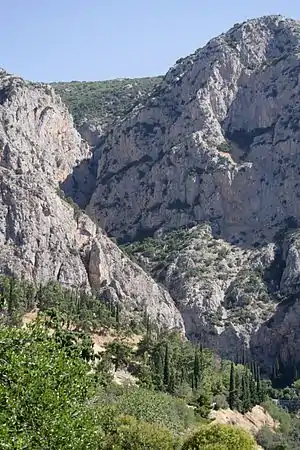
A myth is a story based on fantasy or belief rather than known fact. Ancient Greek culture used them frequently in many different contexts. They are only known to moderns through mention in ancient Greek writings. A writer typically had access to writings at a library or private archive, unless he was wealthy enough to have his own copies made. All books were hand-written. Authors referred to other authors whose books they had before them, or had taken notes from. Often the source of the story was not identified, but even if it was, the source may have taken it from some other book. Sometimes authors wrote down myths related to them orally.
It is thus not possible to date myths. They could have come from any prior time. Often the date of the book relating the myth cannot be determined within centuries. A myth cannot with any certainty be attributed to any century, although the written source may be. Scholars are not entirely without dating methods, however. The content of the myth may resemble or imply circumstances of known or probable provenience. The Iliad, for example, most likely relates myths passed down from the Trojan War, a known Late Bronze Age event.
The Greeks were aided and abetted in their myth-making by the oracles in which they typically devoutly believed. When asked a question, an oracle never gave a direct answer, but spoke in allegories with "hidden meanings" and "ambiguities," said Plutarch, priest of Apollo and historian.[41] It was then incumbent on the inquiring party to interpret them. As the prophecy was regarded as the true word of divinity, the actual meaning, if it could be known, must be historical truth. Believing this principle to be true, many of the best historians spent time trying to intepret oracular myths as actual circumstances.
Some Temple of Apollo appears in the Homeric Literature. In the Iliad, Achilles would not accept Agamemnon's peace offering even if it included all the wealth in the "stone floor" of "rocky Pytho" (I 404). In the Odyssey (θ 79) Agamemnon crosses a "stone floor" to receive a prophecy from Apollo in Pytho, the first known of proto-history.[42] Hesiod also refers to Pytho "in the hollows of Parnassus" (Theogony 498). These references imply that the earliest known date of the oracle's existence is the 8th century BC, the probable date of composition of the Homeric works. Earlier times of existence cannot be excluded if the written poems are adaptations of earlier oral ones.
Beyond these proto-historic tidbits[lower-alpha 13] the main myths of Delphi are given in three literary loci.[43] H.W Parke, the Delphi scholar, complained that they are self-contradictory,[lower-alpha 14] thus unconsciously falling into the Plutarchian epistemology, that they reflect some common, objective historic reality against which the accounts can be compared. Missing is the reality, nor can it be assumed ever to have existed. There is no Apollo, no Zeus, no Hera, and certainly never was a great, dragon-like Python. Not having existed, he did not rot. The myths are pure, Plutarchian figures of speech. meant to be aetiologies of some oracular tradition.
Homeric Hymn 3, "To Apollo," is the oldest of the three loci, dating to the 7th century BC (estimate).[lower-alpha 15] Apollo travels about after his birth on Delos seeking a place for an oracle. He is advised by Telephus to choose Crissa "below the glade of Parnassus," which he does, and has a temple built. Killing the she-dragon that guards the spring, he leaves her to rot, from which the name Pytho, "rotten." Subsequently, some Cretans from Knossos sail up on a mission to reconnoitre Pylos. Changing into a dolphin, Apollo casts himself on deck. The Cretans do not dare to remove him but sail on. Apollo guides the ship around Greece, ending back at Crisa, where the ship grounds. Apollo enters his shrine, with the Cretans to be its priests, worshipping him as Delphineus, "of the dolphin."
Zeus determined the site of Delphi when he sought to find the centre of his "Grandmother Earth" (Gaia). He sent two eagles flying from the eastern and western extremities, and the path of the eagles crossed over Delphi where the omphalos, or navel of Gaia was found.[44][28]
According to Aeschylus in the prologue of the Eumenides, the oracle had origins in prehistoric times and the worship of Gaea, a view echoed by H.W. Parke.[lower-alpha 16]
One tale of the sanctuary's discovery states that a goatherd, who grazed his flocks on Parnassus, one day observed his goats playing with great agility upon nearing a chasm in the rock; the goatherd noticing this held his head over the chasm causing the fumes to go to his brain; throwing him into a strange trance.[46]
The Homeric Hymn to Delphic Apollo recalled that the ancient name of this site had been Krisa.[47]
Others relate that it was named Pytho (Πυθώ) and that Pythia, the priestess serving as the oracle, was chosen from their ranks by a group of priestesses who officiated at the temple. Apollo was said to have slain Python, a "drako" a serpent or a dragon who lived there and protected the navel of the Earth.[48] "Python" (derived from the verb πύθω (pythō),[49] "to rot") is claimed by some to be the original name of the site in recognition of Python which Apollo defeated.[50]
The name Delphi comes from the same root as δελφύς delphys, "womb" and may indicate archaic veneration of Gaia at the site.[lower-alpha 17][lower-alpha 18]
Apollo is connected with the site by his epithet Δελφίνιος Delphinios, "the Delphinian". The epithet is connected with dolphins (Greek δελφίς,-ῖνος) in the Homeric Hymn to Apollo (line 400), recounting the legend of how Apollo first came to Delphi in the shape of a dolphin, carrying Cretan priests on his back. The Homeric name of the oracle is Pytho (Πυθώ).[53] Another legend held that Apollo walked to Delphi from the north and stopped at Tempe, a city in Thessaly, to pick laurel (also known as bay tree) which he considered to be a sacred plant. In commemoration of this legend, the winners at the Pythian Games received a wreath of laurel picked in the temple.
Oracle of Delphi
The prophetic process
Delphi is perhaps best known for its oracle, the Pythia, or sibyl, the duty priestess prophecying from the tripod in the sunken adyton of the Temple of Apollo. Apollo spoke through his oracle. She had to be an older woman of blameless life chosen from among the peasants of the area. Alone in an enclosed inner sanctum (Ancient Greek adyton – "do not enter") she sat on a tripod seat over an opening in the earth (the "chasm"). According to legend, when Apollo slew Python its body fell into this fissure and fumes arose from its decomposing body. Intoxicated by the vapours, the sibyl would fall into a trance, allowing Apollo to possess her spirit. In this state she prophesied. The oracle could not be consulted during the winter months, for this was traditionally the time when Apollo would live among the Hyperboreans. Dionysus would inhabit the temple during his absence.[54]
The time to consult pythia for an oracle during the year is determined from astronomical and geological grounds related to the constellations of Lyra and Cygnus but the hydrocarbon vapours emitted from the chasm.[55] Similar practice was followed in other Apollo oracles too.[56]
While in a trance the Pythia "raved" – probably a form of ecstatic speech – and her ravings were "translated" by the priests of the temple into elegant hexameters. It has been speculated that the ancient writers, including Plutarch who had worked as a priest at Delphi, were correct in attributing the oracular effects to the sweet-smelling pneuma (Ancient Greek for breath, wind or vapour) escaping from the chasm in the rock. That exhalation could have been high in the known anaesthetic and sweet-smelling ethylene or other hydrocarbons such as ethane known to produce violent trances. Though this theory remains debatable the authors put up a detailed answer to their critics.[57][58][59]
Ancient sources describe the priestess using “laurel” to inspire her prophecies. Several alternative plant candidates have been suggested including Cannabis, Hyoscyamus, Rhododendron and Oleander. Harissis claims that a review of contemporary toxicological literature indicates that oleander causes symptoms similar to those shown by the Pythia, and his study of ancient texts shows that oleander was often included under the term "laurel". The Pythia may have chewed oleander leaves and inhaled their smoke prior to her oracular pronouncements and sometimes dying from the toxicity. The toxic substances of oleander resulted in symptoms similar to those of epilepsy, the “sacred disease,” which may have been seen as the possession of the Pythia by the spirit of Apollo.[60]
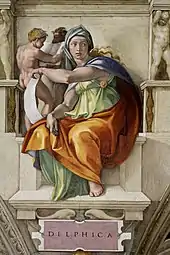
The Delphic oracle exerted considerable influence throughout the Greek world, and she was consulted before all major undertakings including wars and the founding of colonies.[lower-alpha 19] She also was respected by the Greek-influenced countries around the periphery of the Greek world, such as Lydia, Caria, and even Egypt.
The oracle was also known to the early Romans. Rome's seventh and last king, Lucius Tarquinius Superbus, after witnessing a snake near his palace, sent a delegation including two of his sons to consult the oracle.[62]
In 83 BCE a Thracian tribe raided Delphi, burned the temple, plundered the sanctuary and stole the "unquenchable fire" from the altar. During the raid, part of the temple roof collapsed.[63] The same year, the temple was severely damaged by an earthquake, thus it fell into decay and the surrounding area became impoverished. The sparse local population led to difficulties in filling the posts required. The oracle's credibility waned due to doubtful predictions.[64]
The oracle flourished again in the second century CE during the rule of emperor Hadrian, who is believed to have visited the oracle twice and offered complete autonomy to the city.[63] By the 4th century, Delphi had acquired the status of a city.[65] Constantine the Great looted several monuments, most notably the Tripod of Plataea, which he used to decorate his new capital, Constantinople.
Despite the rise of Christianity across the Roman Empire, the oracle remained a religious centre throughout the 4th century, and the Pythian Games continued to be held at least until 424 CE;[65] however, the decline continued. The attempt of Emperor Julian to revive polytheism did not survive his reign.[63] Excavations have revealed a large three-aisled basilica in the city, as well as traces of a church building in the sanctuary's gymnasium.[65] The site was abandoned in the 6th or 7th centuries, although a single bishop of Delphi is attested in an episcopal list of the late 8th and early 9th centuries.[65]
Religious significance of the oracle
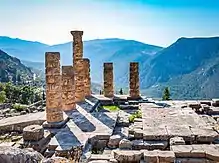
Delphi became the site of a major temple to Phoebus Apollo, as well as the Pythian Games and the prehistoric oracle. Even in Roman times, hundreds of votive statues remained, described by Pliny the Younger and seen by Pausanias. Carved into the temple were three phrases: γνῶθι σεαυτόν (gnōthi seautón = "know thyself") and μηδὲν ἄγαν (mēdén ágan = "nothing in excess"), and Ἑγγύα πάρα δ'ἄτη (engýa pára d'atē = "make a pledge and mischief is nigh"),[66] In antiquity, the origin of these phrases was attributed to one or more of the Seven Sages of Greece by authors such as Plato[67] and Pausanias.[68] Additionally, according to Plutarch's essay on the meaning of the "E at Delphi"—the only literary source for the inscription—there was also inscribed at the temple a large letter E.[69] Among other things epsilon signifies the number 5. However, ancient as well as modern scholars have doubted the legitimacy of such inscriptions.[70] According to one pair of scholars, "The actual authorship of the three maxims set up on the Delphian temple may be left uncertain. Most likely they were popular proverbs, which tended later to be attributed to particular sages."[71]
According to the Homeric hymn to the Pythian Apollo, Apollo shot his first arrow as an infant which effectively slew the serpent Pytho, the son of Gaia, who guarded the spot. To atone the murder of Gaia's son, Apollo was forced to fly and spend eight years in menial service before he could return forgiven. A festival, the Septeria, was held every year, at which the whole story was represented: the slaying of the serpent, and the flight, atonement, and return of the god.[72]
The Pythian Games took place every four years to commemorate Apollo's victory.[72] Another regular Delphi festival was the "Theophania" (Θεοφάνεια), an annual festival in spring celebrating the return of Apollo from his winter quarters in Hyperborea. The culmination of the festival was a display of an image of the gods, usually hidden in the sanctuary, to worshippers.[73]
The theoxenia was held each summer, centred on a feast for "gods and ambassadors from other states." Myths indicate that Apollo killed the chthonic serpent Python guarding the Castalian Spring and named his priestess Pythia after her. Python, who had been sent by Hera, had attempted to prevent Leto, while she was pregnant with Apollo and Artemis, from giving birth.[74]
This spring flowed toward the temple but disappeared beneath, creating a cleft which emitted chemical vapors that purportedly caused the oracle at Delphi to reveal her prophecies. Apollo killed Python but had to be punished for it, since he was a child of Gaia. The shrine dedicated to Apollo was originally dedicated to Gaia and shared with Poseidon.[72] The name Pythia remained as the title of the Delphic oracle.
Erwin Rohde wrote that the Python was an earth spirit, who was conquered by Apollo, and buried under the omphalos, and that it is a case of one deity setting up a temple on the grave of another.[75] Another view holds that Apollo was a fairly recent addition to the Greek pantheon coming originally from Lydia. The Etruscans coming from northern Anatolia also worshipped Apollo,[76] and it may be that he was originally identical with Mesopotamian Aplu, an Akkadian title meaning "son", originally given to the plague God Nergal, son of Enlil. Apollo Smintheus (Greek Απόλλων Σμινθεύς), the mouse killer[77] eliminates mice, a primary cause of disease, hence he promotes preventive medicine.
History
Occupation of the site at Delphi can be traced back to the Neolithic period with extensive occupation and use beginning in the Mycenaean period (1600–1100 BC).
Ancient Delphi
Earlier myths [78][28] include traditions that Pythia, or the Delphic oracle, already was the site of an important oracle in the pre-classical Greek world (as early as 1400 BC) and, rededicated from about 800 BC, when it served as the major site during classical times for the worship of the god Apollo.
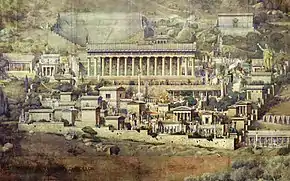
Delphi was since ancient times a place of worship for Gaia, the mother goddess connected with fertility. The town started to gain pan-Hellenic relevance as both a shrine and an oracle in the 7th century BC. Initially under the control of Phocaean settlers based in nearby Kirra (currently Itea), Delphi was reclaimed by the Athenians during the First Sacred War (597–585 BC). The conflict resulted in the consolidation of the Amphictyonic League, which had both a military and a religious function revolving around the protection of the Temple of Apollo. This shrine was destroyed by fire in 548 BC and then fell under the control of the Alcmaeonids banned from Athens. In 449–448 BC, the Second Sacred War (fought in the wider context of the First Peloponnesian War between the Peloponnesian League led by Sparta and the Delian-Attic League led by Athens) resulted in the Phocians gaining control of Delphi and the management of the Pythian Games.
In 356 BC the Phocians under Philomelos captured and sacked Delphi, leading to the Third Sacred War (356–346 BC), which ended with the defeat of the former and the rise of Macedon under the reign of Philip II. This led to the Fourth Sacred War (339 BC), which culminated in the Battle of Chaeronea (338 BC) and the establishment of Macedonian rule over Greece. In Delphi, Macedonian rule was superseded by the Aetolians in 279 BC, when a Gallic invasion was repelled, and by the Romans in 191 BC. The site was sacked by Lucius Cornelius Sulla in 86 BC, during the Mithridatic Wars, and by Nero in 66 AD. Although subsequent Roman emperors of the Flavian dynasty contributed towards to the restoration of the site, it gradually lost importance. In the course of the 3rd century mystery cults became more popular than the traditional Greek pantheon. Christianity, which started as yet one more mystery cult, soon gained ground, and this eventually resulted in the persecution of pagans in the late Roman Empire. The anti-pagan legislation of the Flavian dynasty deprived ancient sanctuaries of their assets. The emperor Julian attempted to reverse this religious climate, yet his "pagan revival" was particularly short-lived. When the doctor Oreibasius visited the oracle of Delphi, in order to question the fate of paganism, he received a pessimistic answer:
Εἴπατε τῷ βασιλεῖ, χαμαὶ πέσε δαίδαλος αὐλά,
οὐκέτι Φοῖβος ἔχει καλύβην, οὐ μάντιδα δάφνην,
οὐ παγὰν λαλέουσαν, ἀπέσβετο καὶ λάλον ὕδωρ.
[Tell the king that the flute has fallen to the ground. Phoebus does not have a home any more, neither an oracular laurel, nor a speaking fountain, because the talking water has dried out.]
It was shut down during the persecution of pagans in the late Roman Empire by Theodosius I in 381 AD.[79]
Amphictyonic Council
The Amphictyonic Council was a council of representatives from six Greek tribes that controlled Delphi and also the quadrennial Pythian Games. They met biannually and came from Thessaly and central Greece. Over time, the town of Delphi gained more control of itself and the council lost much of its influence.
The sacred precinct in the Iron Age
Excavation at Delphi, which was a post-Mycenaean settlement of the late 9th century, has uncovered artifacts increasing steadily in volume beginning with the last quarter of the 8th century BC. Pottery and bronze as well as tripod dedications continue in a steady stream, in contrast to Olympia. Neither the range of objects nor the presence of prestigious dedications proves that Delphi was a focus of attention for a wide range of worshippers, but the large quantity of valuable goods, found in no other mainland sanctuary, encourages that view.
Apollo's sacred precinct in Delphi was a Panhellenic Sanctuary, where every four years, starting in 586 BC[80] athletes from all over the Greek world competed in the Pythian Games, one of the four Panhellenic Games, precursors of the Modern Olympics. The victors at Delphi were presented with a laurel crown (stephanos) which was ceremonially cut from a tree by a boy who re-enacted the slaying of the Python.[80] (These competitions are also called stephantic games, after the crown.) Delphi was set apart from the other games sites because it hosted the mousikos agon, musical competitions.[50]
These Pythian Games rank second among the four stephantic games chronologically and in importance.[80] These games, though, were different from the games at Olympia in that they were not of such vast importance to the city of Delphi as the games at Olympia were to the area surrounding Olympia. Delphi would have been a renowned city regardless of whether it hosted these games; it had other attractions that led to it being labeled the "omphalos" (navel) of the earth, in other words, the centre of the world.[80][81]
In the inner hestia (hearth) of the Temple of Apollo, an eternal flame burned. After the battle of Plataea, the Greek cities extinguished their fires and brought new fire from the hearth of Greece, at Delphi; in the foundation stories of several Greek colonies, the founding colonists were first dedicated at Delphi.[82]
Abandonment and rediscovery
.jpg.webp)
The Ottomans finalized their domination over Phocis and Delphi in about 1410CE. Delphi itself remained almost uninhabited for centuries. It seems that one of the first buildings of the early modern era was the monastery of the Dormition of Mary or of Panagia (the Mother of God) built above the ancient gymnasium at Delphi. It must have been towards the end of the 15th or in the 16th century that a settlement started forming there, which eventually ended up forming the village of Kastri.
Ottoman Delphi gradually began to be investigated. The first Westerner to describe the remains in Delphi was Ciriaco de' Pizzicolli (Cyriacus of Ancona), a 15th-century merchant turned diplomat and antiquarian. He visited Delphi in March 1436 and remained there for six days. He recorded all the visible archaeological remains based on Pausanias for identification. He described the stadium and the theatre at that date as well as some freestanding pieces of sculpture. He also recorded several inscriptions, most of which are now lost. His identifications however were not always correct: for example he described a round building he saw as the temple of Apollo while this was simply the base of the Argives' ex-voto. A severe earthquake in 1500 caused much damage.
In 1766 an English expedition funded by the Society of Dilettanti included the Oxford epigraphist Richard Chandler, the architect Nicholas Revett, and the painter William Pars. Their studies were published in 1769 under the title Ionian Antiquities,[83] followed by a collection of inscriptions,[84] and two travel books, one about Asia Minor (1775),[85] and one about Greece (1776).[86] Apart from the antiquities, they also related some vivid descriptions of daily life in Kastri, such as the crude behaviour of the Turco-Albanians who guarded the mountain passes.
In 1805 Edward Dodwell visited Delphi, accompanied by the painter Simone Pomardi.[87] Lord Byron visited in 1809, accompanied by his friend John Cam Hobhouse:
Yet there I've wandered by the vaulted rill;
Yes! Sighed o'er Delphi's long deserted shrine,
where, save that feeble fountain, all is still.
He carved his name on the same column in the gymnasium as Lord Aberdeen, later Prime Minister, who had visited a few years before. Proper excavation did not start until the late 19th century (see "Excavations" section) after the village had moved.
Depiction in art
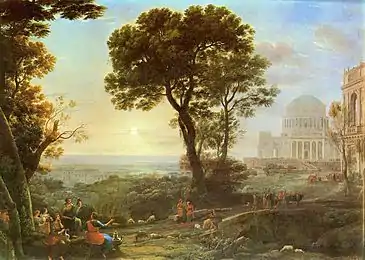
From the 16th century onward, West Europe developed an interest in Delphi. In the mid-15th century, Strabo was first translated into Latin. The earliest depictions of Delphi were totally imaginary, created by the German N. Gerbel, who published in 1545 a text based on the map of Greece by N. Sofianos. The ancient sanctuary was depicted as a fortified city.
The first travelers with archaeological interests, apart from the precursor Cyriacus of Ancona, were the British George Wheler and the French Jacob Spon, who visited Greece in a joint expedition in 1675–1676. They published their impressions separately. In Wheler's "Journey into Greece", published in 1682, a sketch of the region of Delphi appeared, where the settlement of Kastri and some ruins were depicted. The illustrations in Spon's publication "Voyage d'Italie, de Dalmatie, de Grèce et du Levant, 1678" are considered original and groundbreaking.
Travelers continued to visit Delphi throughout the 19th century and published their books which contained diaries, sketches, views of the site as well as pictures of coins. The illustrations often reflected the spirit of romanticism, as evident by the works of Otto Magnus von Stackelberg, where, apart from the landscapes (La Grèce. Vues pittoresques et topographiques, Paris 1834) are depicted also human types (Costumes et usages des peuples de la Grèce moderne dessinés sur les lieux, Paris 1828). The philhellene painter W. Williams has comprised the landscape of Delphi in his themes (1829). Influential personalities such as F.Ch.-H.-L. Pouqueville, W.M. Leake, Chr. Wordsworth and Lord Byron are amongst the most important visitors of Delphi.

After the foundation of the modern Greek state, the press became also interested in these travelers. Thus "Ephemeris" writes (17 March 1889): In the Revues des Deux Mondes Paul Lefaivre published his memoirs from an excursion to Delphi. The French author relates in a charming style his adventures on the road, praising particularly the ability of an old woman to put back in place the dislocated arm of one of his foreign traveling companions, who had fallen off the horse. "In Arachova the Greek type is preserved intact. The men are rather athletes than farmers, built for running and wrestling, particularly elegant and slender under their mountain gear." Only briefly does he refer to the antiquities of Delphi, but he refers to a pelasgian wall 80 meters long, "on which innumerable inscriptions are carved, decrees, conventions, manumissions."
Gradually the first travelling guides appeared. The revolutionary "pocket" books invented by Karl Baedeker, accompanied by maps useful for visiting archaeological sites such as Delphi (1894) and the informed plans, the guides became practical and popular. The photographic lens revolutionized the way of depicting the landscape and the antiquities, particularly from 1893 onwards, when the systematic excavations of the French Archaeological School started. However, artists such as Vera Willoughby, continued to be inspired by the landscape.
Delphic themes inspired several graphic artists. Besides the landscape, Pythia/Sibylla become an illustration subject even on Tarot cards.[88] A famous example constitutes Michelangelo's Delphic Sibyl (1509),[89][90][91] the 19th-century German engraving Oracle of Apollo at Delphi, as well as the recent ink on paper drawing "The Oracle of Delphi" (2013) by M. Lind.[92] Modern artists are inspired also by the Delphic Maxims. Examples of such works are displayed in the "Sculpture park of the European Cultural Center of Delphi" and in exhibitions taking place at the Archaeological Museum of Delphi.
Description in literature
Delphi inspired literature as well. In 1814 W. Haygarth, friend of Lord Byron, refers to Delphi in his work "Greece, a Poem". In 1888 Charles Marie René Leconte de Lisle published his lyric drama L’Apollonide, accompanied by music by Franz Servais. More recent French authors used Delphi as a source of inspiration such as Yves Bonnefoy (Delphes du second jour) or Jean Sullivan (nickname of Joseph Lemarchand) in L'Obsession de Delphes (1967), but also Rob MacGregor's Indiana Jones and the Peril at Delphi (1991).
The presence of Delphi in Greek literature is very intense. Poets such as Kostis Palamas (The Delphic Hymn, 1894), Kostas Karyotakis (Delphic festival, 1927), Nikephoros Vrettakos (return from Delphi, 1957), Yannis Ritsos (Delphi, 1961–62) and Kiki Dimoula (Gas omphalos and Appropriate terrain 1988), to mention only the most renowned ones. Angelos Sikelianos wrote The Dedication (of the Delphic speech) (1927), the Delphic Hymn (1927) and the tragedy Sibylla (1940), whereas in the context of the Delphic idea and the Delphic festivals he published an essay titled "The Delphic union" (1930). The nobelist George Seferis wrote an essay under the title "Delphi", in the book "Dokimes".
The importance of Delphi for the Greeks is significant. The site has been recorded on the collective memory and have been expressed through tradition. Nikolaos Politis, the famous Greek ethnographer, in his Studies on the life and language of the Greek people - part A, offers two examples from Delphi:
- a) the priest of Apollo (176)
When Christ was born a priest of Apollo was sacrificing below the monastery of Panayia, on the road of Livadeia, on a site called Logari. Suddenly he abandoned the sacrifice and says to the people: "in this moment was born the son of God, who will be very powerful, like Apollo, but then Apollo will beat him". He didn't have time to finish his speech and a thunder came down and burnt him, opening the rock nearby into two. [p. 99]
- b)The Mylords (108)
The Mylords are not Christians, because nobody ever saw them cross themselves. They originate from the old pagan inhabitants of Delphi who kept their property in castle called Adelphi, named after the two brother princes who built it. When Christ and his mother came to the site, and all people around converted to Christianity they thought that they should better leave; thus the Mylords left for the West and took all their belongings with them. The Mylords come here now and worship these stones. [p. 59]
Gallery
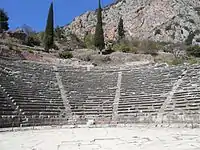 The theatre at Delphi
The theatre at Delphi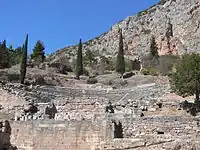 Ruins of the theatre at Delphi
Ruins of the theatre at Delphi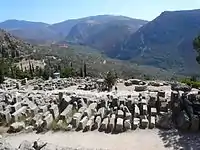 Stacked stones
Stacked stones
See also
- Aristoclea, Delphic priestess of the 6th century BC, said to have been tutor to Pythagoras
- Delphi Archaeological Museum
- Ex voto of the Attalids (Delphi)
- Franz Weber (activist) - made an honorary citizen of Delphi in 1997
- Greek art
- List of traditional Greek place names
- Online books, and library resources in your library and in other libraries about Delphi
Footnotes
- In English, the name Delphi is pronounced either as /ˈdɛlfaɪ/ or, in a more Greek-like manner, as /ˈdɛlfiː/. The bottom line on the etymology is that Delphoi is related to delphus, "womb," which is consistent with the omphalos stone there being considered the "navel" of the universe. The delphis, or "dolphin" connection, is an accidental result of the dolpins being named from their uterus-like appearance. The full etymology is to be found in Frisk.[1] The inscriptional variants, Dalphoi, Dolphoi, Derphoi,[2] might appear to be dialects, especially Dalphoi, usually taken as Phocian, as the Phocians spoke Doric. Frisk labels them as secondary developments, including the apparent Doric original a in Dalphoi. It could well be Phocian, but was not originally Doric. The true dialect form, Aeolic Belphoi, with Delphoi, must be reflexes of a Bronze Age *Gwelphoi, which does not have an original "a."[3] Frisk's Proto-Indoeuropean is *gwelbh-u-, with a -u- extension. Without the extension there is no relation between Delphoi and delphus. However, Frisk, a major Indo-Europeanist, cites some parallels of -woi- to -oi- in other words. The evidence from mythology adds strength to his hypothesis. Without the w, Delphoi is not related to Delphus, but only seems so. The etymology of dolphin is fairly standard.
- Some of the photographs taken from Delphi depict a glistening river coursing toward a glistening Gulf of Corinth. While the gulf may glisten, the apparent glisten of the river is an illusion. Either the photograph has been retouched for "postcard" purposes or the limestone bed is shown glistening. The gradient is too steep for any meandering river bed. Much of the river courses through underground channels eroded in the Karst topography.
- "Tectonic" is a term referring to roofs in architecture
- Cimmerides is "the orogenic system related to the obliteration of Paleo-Tethys". Alpides is "that generated during the closure of Neo-Tethys." Tethysides is the both together. The idea is that within the same orogenic zones the Alpides exist superimposed on the older Cimmerides.
- Alpide cannot be used as a synonym for Alpine. The latter refers only to the Alps, Carpathians, Dinaric Alps, and Hellenides. They are also Alpides by virtue of being in the Alpide system. But, not every Alpide is Alpine. The uniting factor is that the Alpides were thrown up on the shore of Neo-Tethys, which went across what is now Eurasia to the Pacific. Moreover, although there was an Alpine orogeny, there was never an Alpide orogeny, the Alpide being a system of orogenies named something else.
- "The dislocations visible in the rocky crust of the Earth are the result of movements which are produced by a decrease in the volume of our planet." The theory failed finally on the discovery by more precise methods that the planet is not decreasing and has not decreased since the loss of the moon from it.
- Use of "foreland" has tended to be free and innovative. Anything not hinterland is foreland. Suess refers to all of northern Europe as foreland to the Alps. In contrast to the continental drift theorists, he regarded this foreland as moving south to squeeze up the Alps.
- The "-ides" names are innovated freely by geologists studying the rocks of specific regions. They are to a large extent produced words, which are words innovated from elements of known meanings to produce another meaning readily understood from its elements; e.g., ductile and ductibility.
- Suess regarded the oceans as compressional subsidences reducing tangential distance by tilting them into the vertical.[17]
- A larger Africa, named by Suess from the beds in Gondwana of Central India.
- Moderately technical article, highly condensed. The authors summarize and criticize three models, the first of which is covered in this note. In the "Slab Pull Model" the slab (overriding plate) "rolls back"; i.e., moves opposite to the direction of subduction. The foredeep offers a vacuum of balancing compressional forces, so the newly raised arc slides into it, at the same time pushing it back. The authors argue that the coefficient of friction is too high for such a rollback. They oppose subduction-related causes in favor of non-subduction-related ones, such as the Extrusion Theory, in which an originally wide-spread arc is squeezed or extruded into a narrower area, weakening the crust around it. The question asked by their title underscores the difficulty in finding a model that will fit all the different types of subduction.
- The "speaking water" is much criticised because it is the Pythia that speaks, not the water. However, a standard feature of oracular response from Apollo is the requirement that the priestess drink from a spring of fresh water, considered sacred. It is certain that the spring captured at the chasm was piped to the adyton in the temple.
- Those who argue for an entirely literary manufacture of the poems do not recognize any proto-history in them. The prevalent archaeological view is that with regards to geographic detail they are in fact mainly proto-historic.
- "All three versions, instead of being simple and traditional, are already selective and tendentious. They disagree with each other...."
- The poem has two parts, "To Delian Apollo" and "To Pythian Apollo." The Pytho myth is only in the latter.
- The foundation of the oracle is described by three early writers: the author of the Homeric Hymn to Apollo, Aeschylus in the prologue to the Eumenides, and Euripides in a chorus in the Iphigeneia in Tauris. Parke goes on to say, "This version [Euripides] evidently reproduces in a sophisticated form the primitive tradition which Aeschylus for his own purposes had been at pains to contradict: the belief that Apollo came to Delphi as an invader and appropriated for himself a previously existing oracle of Earth. The slaying of the serpent is the act of conquest which secures his possession; not as in the Homeric Hymn, a merely secondary work of improvement on the site. Another difference is also noticeable. The Homeric Hymn, as we saw, implied that the method of prophecy used there was similar to that of Dodona: both Aeschylus and Euripides, writing in the fifth century, attribute to primeval times the same methods as used at Delphi in their own day. So much is implied by their allusions to tripods and prophetic seats. ... [continuing on p. 6] ... Another very archaic feature at Delphi also confirms the ancient associations of the place with the Earth goddess. This was the Omphalos, an egg-shaped stone which was situated in the innermost sanctuary of the temple in historic times. Classical legend asserted that it marked the 'navel' (Omphalos) or center of the Earth and explained that this spot was determined by Zeus who had released two eagles to fly from opposite sides of the earth and that they had met exactly over this place". On p.7 he writes further, "So Delphi was originally devoted to the worship of the Earth goddess whom the Greeks called Ge, or Gaia. Themis, who is associated with her in tradition as her daughter and partner or successor, is really another manifestation of the same deity: an identity that Aeschylus himself recognized in another context. The worship of these two, as one or distinguished, was displaced by the introduction of Apollo. His origin has been the subject of much learned controversy: it is sufficient for our purpose to take him as the Homeric Hymn represents him – a northern intruder – and his arrival must have occurred in the dark interval between Mycenaean and Hellenic times. His conflict with Ge for the possession of the cult site was represented under the legend of his slaying the serpent.[45]
- Such was its prestige that most Hellenes after 500 BCE placed its foundation in the earliest days of the world: before Apollo took possession, they said, Ge (Earth) (Gaia) and her daughter Themis had spoken oracles at Pytho. Such has been the strength of the tradition that many historians and others have accepted as historical fact the ancient statement that Ge and Themis spoke oracles before it became Apollo's establishment, yet nothing but the myth supports this statement. In the earliest account known of the Delphic oracle's beginnings, the story found in the Homeric Hymn to Apollo (281–374), there was no oracle before Apollo came and killed the great she-dragon, Pytho's only inhabitant. This was apparently the Delphic myth of the sixth century.[51]
- The earth is the abode of the dead, therefore the earth-deity has power over the ghostly world: the shapes of dreams, which often foreshadowed the future, were supposed to ascend from the world below, therefore the earth-deity might acquire an oracular function, especially through the process of incubation, in which the consultant slept in a holy shrine with his ear upon the ground. That such conceptions attached to Gaia is shown by the records of her cults at Delphi, Athens, and Aegae. A recently discovered inscription speaks of a temple of Ge at Delphi. ... As regards Gaia, we also can accept it. It is confirmed by certain features in the latter Delphic divination, and also by the story of the Python.[52]
- Because the founding of the city was for the Greeks, as it had been for earlier cultures, primarily a religious act, Delphi naturally assumed charge of the new foundations; and especially in the early period of colonization, the Pythian Apollo gave specific advice that dispatched new colonies in every direction, under the aegis of Apollo himself. Few cities would undertake such an expedition without consulting the oracle. Thus at a moment when the growth of population might have led to congestion within the city, to random emigration, or to conflicts for arable land in the more densely populated regions, Delphi, willy-nilly, faced the problem and conducted a program of organized dispersal.[61]
Citations
- Frisk, Hjalmar (1960). "δελφίς, Δελφοί, δελφύς". Griechisches Etymologisches Wörterbuch. Band I. Heidelberg: Carl Winter.
- Also given in Henry George Liddell; Robert Scott; Henry Stuart Jones (1940). "Δελφοί". A Greek-English Lexicon. Perseus Digital Library.
- Alice Mouton; Ian Rutherford; Ilya Yakubovich (2013). Luwian Identities: Culture, Language and Religion Between Anatolia and the Aegean. Leiden: Brill. p. 66.
- Suda, pi,3137
- Suda, delta,210
- Kase 1970, pp. 1-2
- Kase 1970, pp. 4-5
- Kase 1970, p. 5
- Kase 1970, pp. 16-17
- Kase 1970, pp. 28-29
- Peltier, W.R. (1989). "Chapter 1 Mantle Convection and Plate Tectonics: the Emergence Paradigm in Global Geodynamics". In Peltier, W.R. (ed.). Mantle Convection: Plate Tectonics and Global Dynamics. Gordon and Breach Science Publishers. pp. 1–2.
- Şengör, A. M. Celâl (1984). "The Definition of the Terms Alpide, Cimmeride, and Tethyside, and the Purpose of This Paper". The Cimmeride orogenic system and the tectonics of Eurasia. Special Paper 195. Boulder, Colorado: Geological Society of America. pp. 11–13. Translation from the Turkish.
- Suess 1904, p. 107, Part I Chapter 3 "Dislocations"
- "Geosynclinal Theory". The Emergence and Evolution of Plate Tectonics. University of Illinois. 2020. Retrieved 14 November 2020.
- Suess 1909, pp. 626-627, Part V, Chapter XVII
- Suess 1908, pp. 1-4, Part IV, Chapter 1, Introduction
- Suess 1906, p. 536, Part 2, Chapter 14, "The Oceans"
- Suess 1908, pp. 196-197, Part 4, Chapter 5, "The Altaides"
- E. Mantovani; M. Vivi; D. Babbucci; C. Tamburelli; D. Albarell (2001). "Back arc extension: which driving mechanism?" (PDF). Journal of the Virtual Explorer. 3 (Paper 25): 4–21. doi:10.3809/jvirtex.2001.00025. Retrieved 4 December 2020.
- Gregory, Timothy E. (1983). "Julian and the last oracle at Delphi". Greek, Roman, and Byzantine Studies. 24 (4).
- Delphi Archived 2005-04-01 at the Wayback Machine, Hellenic Ministry of Culture.
- Petrides, P., 1997, «Delphes dans l’Antiquité tardive : première approche topographique et céramologique», BCH 121, 681-695
- Petrides, P., 2003, «Αteliers de potiers protobyzantins à Delphes », in Χ. ΜΠΑΚΙΡΤΖΗΣ (ed.), 7ο Διεθνές Συνέδριο Μεσαιωνικής Κεραμικής της Μεσογείου, Θεσσαλονίκη 11-16 Οκτωβρίου 1999, Πρακτικά, Αθήνα, 443-446
- Petrides, P., 2005, «Un exemple d’architecture civile en Grèce: les maisons protobyzantines de Delphes (IVe–VIIe s.)», Mélanges Jean-Pierre Sodini, Travaux et Mémoires 15, Paris, pp.193-204.
- Sakoulas, Thomas. "Delphi Archaeological Site". Ancient-Greece.org. Retrieved 16 November 2020.
- Sakoulas, Thomas. "Temple of Apollo at Delphi". Ancient-Greece.org. Retrieved 28 November 2016.
- Bowra, C.M. (2000). Pindar. Oxford University Press. pp. 373–75.
- Harissis 2019
- Bommelaer, J.-F. (1991). Guide de Delphes: Le site. Paris: Laroche, D. pp. 207–212.
- Delphi Theater at Ancient-Greece.org.
- Bommelaer, J.-F. «Das Theater», in Maas, M. (ed), Delphi. Orakel am Nabel der Welt, Karlsruhe 1996, pp.95-105
- Mulliez, D., “Οι πυθικοί αγώνες. Οι μαρτυρίες των επιγραφών”, in Κολώνια, Ρ. (ed.), Αρχαία Θέατρα της Στερεάς Ελλάδας, Διάζωμα, Αθήνα 2013, 147-154
- http://www.diazoma.gr/200-Stuff-06-Theatres/DataSheet_Delfon.pdf
- Χλέπα, Ε.-Α., Παπαντωνόπουλος, Κ., «Τεκμηρίωση και αποκατάσταση του αρχαίου θεάτρου Δελφών», in Κολώνια, Ρ. (ed.), Αρχαία Θέατρα της Στερεάς Ελλάδας, Διάζωμα, Αθήνα 2013, 173-198
- "Marcus Vitruvius Pollio: de Architectura, Book VII". University of Chicago. Retrieved 14 June 2017.
- Delphi Stadium at Ancient-Greece.org.
- Pindar: Pythian 3
- "Hippodrome of ancient Delphi located". archaeologynewsnetwork.blogspot.co.uk. Retrieved 14 April 2018.
- Manumission Wall at Ashes2Art; Manumission of female slaves at Delphi at attalus.org.
- Miller 2004, p. 98.
- Harissis 2019, p. 89
- Lloyd-Jones 1976, p. 60
- Parke 1939, p. 6
- Graves, Robert (1993), "The Greek Myths: Complete Edition" (Penguin, Harmondsworth)
- Herbert William Parke, The Delphic Oracle, v. 1, p. 3.
- William Godwin (1876). Lives of the Necromancers. London, F. J. Mason. p. 11.
- Hymn to Pythian Apollo, l. 254–74: Telphousa recommends to Apollo to build his oracle temple at the site of "Krisa below the glades of Parnassus".
- Konstaninou, Ioanna "Delphi: the Oracle and its Role in the Political and Social Life of the Ancient Greeks" (Hannibal Publishing House, Athens)
- LSJ s.v. πύθω.
- Miller 2004, p. 95.
- Fontenrose, Joseph (1978). The Delphic Oracle: Its Responses and Operations, with a Catalogue of Responses, pp. 3–4.
- Farnell, Lewis Richard, The Cults of the Greek States, v. III, pp. 8–10, onwards.
- Odyssey, VIII, 80
- See e.g. Fearn 2007, p. 182
- Liritzis, I.; Castro, B. (2013). "Delphi and Cosmovision: Apollo's absence at the land of the hyperboreans and the time for consulting the oracle". Journal of Astronomical History and Heritage. 16 (2): 184. Bibcode:2013JAHH...16..184L.
- Castro, Belen; Liritzis, Ioannis; Nyquist, Anne (2015). "Oracular Functioning And Architecture of Five Ancient Apollo Temples Through Archaeastronomy: Novel Approach And Interpretation". Interpretation Nexus Network Journal, Architecture & Mathematics. 18 (2): 373. doi:10.1007/s00004-015-0276-2.
- Spiller, Henry A.; Hale, John R.; de Boer, Jelle Z. (2002). "The Delphic Oracle: A Multidisciplinary Defense of the Gaseous Vent Theory" (PDF). Clinical Toxicology. 40 (2): 189–196. doi:10.1081/clt-120004410. PMID 12126193. S2CID 38994427.
- John Roach (14 August 2001). "Delphic Oracle's Lips May Have Been Loosened by Gas Vapors". National Geographic. Retrieved 8 March 2007.
- Spiller, Henry; de Boer, Jella; Hale, John R.; Chanton, Jeffery (2008). "Gaseous emissions at the site of the Delphic Oracle: Assessing the ancient evidence". Clinical Toxicology. 46 (5): 487–488. doi:10.1080/15563650701477803. PMID 18568810. S2CID 12441885.
- Harissis, Haralampos V. (2014). "A Bittersweet Story: The True Nature of the Laurel of the Oracle of Delphi". Perspect. Biol. Med. 57 (3): 351–360. doi:10.1353/pbm.2014.0032. PMID 25959349. S2CID 9297573. Retrieved 27 November 2016.
- Lewis Mumford, The City in History. New York: Harcourt, Brace & World, 1961; p. 140.
- Livy, Ab urbe condita, 1.56
- Lampsas Giannis (1984) Dictionary of the Ancient World (Lexiko tou Archaiou Kosmou), Vol. I, Athens, Domi Publications, pp. 761-762
- Wood, Michael (2003). The road to Delphi : the life and afterlife of oracles (1st ed.). New York: Farrar, Straus, and Giroux. ISBN 0-374-52610-9. OCLC 52090516.
- Gregory, Timothy E. (1991). "Delphi". In Kazhdan, Alexander (ed.). Oxford Dictionary of Byzantium. London; New York: Oxford University Press. p. 602. ISBN 978-0-19-504652-6.
- Plato, Charmides 164d–165a.
- Plato, Protagoras 343a–b at the Perseus Project.
- Pausanias, Description of Greece, Phocis and Ozolian Locri, 10.24.1 at the Perseus Project.
- Hodge, A. Trevor. "The Mystery of Apollo's E at Delphi," American Journal of Archaeology, Vol. 85, No. 1. (Jan., 1981), pp. 83–84.
- H. Parke and D. Wormell, The Delphic Oracle, (Basil Blackwell, 1956), vol. 1, pp. 387–389.
- Parke & Wormell, p. 389.
- Cf. Seyffert, Dictionary of Classic Antiquities, article on "Delphic Oracle"
- James Hall, A History of Ideas and Images in Italian Art, pp 70–71, 1983, John Murray, London, ISBN 0719539714
- Michael Grant; John Hazel (2 August 2004). Who's Who in Classical Mythology. Routledge. p. 61. ISBN 978-1-134-50943-0.
- Rodhe, E (1925), "Psyche: The Cult of Souls and the Belief in Immortality among the Greeks", trans. from the 8th edn. by W. B. Hillis (London: Routledge & Kegan Paul, 1925; reprinted by Routledge, 2000). p.97.
- Stevens, Natalie L. C. (2009). "A New Reconstruction of the Etruscan Heaven". American Journal of Archaeology. 113 (2): 153–164. doi:10.3764/aja.113.2.153. JSTOR 20627565.
- Entry: σμινθεύς Archived 2009-12-02 at the Wayback Machine at Henry George Liddell, Robert Scott, A Greek-English Lexicon
- Pausanias 10.12.1
- Grecia. Guida d'Europa (in Italian). Milano: Touring Club Italiano. 1977. p. 126.
- Miller 2004, p. 96.
- Miller 2004, p. 97.
- Burkert 1985, pp. 61, 84.
- Chandler, R, Revett, N., Pars, W., Ionian Antiquities, London 1769
- Chandler, R, Revett, N., Pars, W., Inscriptiones antiquae, pleraeque nondum editae, in Asia Minore et Graecia, praesertim Athensis, collectae, Oxford, 1774
- Chandler, R, Revett, N., Pars, W., Travels in Asia Minor, Oxford, 1775.
- Chandler, R, Revett, N., Pars, W., Travels in Greece, Oxford, 1776.
- A classical and topographical tour through Greece, London 1819
- "Tarot of Delphi". www.aeclectic.net. Retrieved 14 April 2018.
- Michelangelo (1509). Delphic Sibyl. Wikimedia Commons (painting).
- John Collier (1891). The Priestess of Delphi (painting).
- John William Waterhouse (1882). Consulting the Oracle. JWWaterhouse.com (painting).
- Malin Lind (22 January 2013). The Oracle of Delphi. theshapeshifter.wordpress.com (ink on paper). Delphi – Art, creation of life. Retrieved 14 April 2018.
Citation references
- Broad, William J. The Oracle: Ancient Delphi and the Science Behind its Lost Secrets, New York : Penguin, 2006. ISBN 1-59-420081-5.
- Burkert, Walter (1985). Greek Religion.
- Connelly, Joan Breton, Portrait of a Priestess: Women and Ritual in Ancient Greece, Princeton University Press, 2007. ISBN 0691127468
- Call of Duty: Black Ops 4 (2018) "Ancient Evil"
- Dempsey, T., Reverend, The Delphic oracle, its early history, influence and fall, Oxford: B.H. Blackwell, 1918.
- Castro Belen, Liritzis Ioannis and Nyquist Anne (2015) Oracular Functioning And Architecture of Five Ancient Apollo Temples Through Archaeastronomy: Novel Approach And Interpretation Nexus Network Journal, Architecture & Mathematics, 18(2), 373-395 (DOI:10.1007/s00004-015-0276-2)
- Farnell, Lewis Richard, The Cults of the Greek States, in five volumes, Clarendon Press, 1896–1909. (Cf. especially, volume III and volume IV on the Pythoness and Delphi).
- Fearn, David (2007). Bacchylides: Politics, Performance, Poetic Tradition. Oxford University Press. ISBN 9780199215508.
- Fontenrose, Joseph Eddy, The Delphic oracle, its responses and operations, with a catalogue of responses, Berkeley: University of California Press, 1978. ISBN 0520033604
- Fontenrose, Joseph Eddy, Python; a study of Delphic myth and its origins, New York, Biblio & Tannen, 1974. ISBN 081960285X
- Goodrich, Norma Lorre, Priestesses, New York: F. Watts, 1989. ISBN 0531151131
- Guthrie, William Keith Chambers, The Greeks and their Gods, 1955.
- Hall, Manly Palmer, The Secret Teachings of All Ages, 1928. Ch. 14 cf. Greek Oracles, www, PRS
- Harissis H. 2015. “A Bittersweet Story: The True Nature of the Laurel of the Oracle of Delphi” Perspectives in Biology and Medicine. Volume 57, Number 3, Summer 2014, pp. 295-298.
- Harissis, H. (2019). "Pindar's Paean 8 and the birth of the myth of the first temples of Delphi". Acta Classica: Proceedings of the Classical Association of South Africa. 62 (1): 78 - 123.
- Herodotus, The Histories
- Homeric Hymn to Pythian Apollo
- Kase, Edward W. (1970). A Study of the Role of Krisa in the Mycenaean Era (Master's Thesis). Loyola University. Docket 2467.
- Liritzis, I; Castro, Β (2013). "Delphi and Cosmovision: Apollo's absence at the land of the hyperboreans and the time for consulting the oracle". Journal of Astronomical History and Heritage. 16 (2): 184–206. Bibcode:2013JAHH...16..184L.
- Lloyd-Jones, Hugh (1976). "The Delphic Oracle". Greece & Rome. 23 (1): 60–73. doi:10.1017/S0017383500018283.
- Manas, John Helen, Divination, ancient and modern, New York, Pythagorean Society, 1947.
- Miller, Stephen G. (2004). Ancient Greek Athletics. New Haven and London: Yale University Press.
- Parke, Herbert William (1939). A history of the Delphic oracle. Oxford: Basil Blackwell.
- Plutarch "Lives"
- Rohde, Erwin, Psyche, 1925.
- Seyffert, Oskar, "Dictionary of Classical Antiquities", London: W. Glaisher, 1895.
- Spiller, Henry A., John R. Hale, and Jelle Z. de Boer. "The Delphic Oracle: A Multidisciplinary Defense of the Gaseous Vent Theory." Clinical Toxicology 40.2 (2000) 189–196.
- Suess, Eduard (1904). Sollas, W J (ed.). The face of the earth (Das antlitz der erde). Volume I. Translated by Sollas, Hertha B C. Oxford: Clarendon Press.
- Suess, Eduard (1906). Sollas, W J (ed.). The face of the earth (Das antlitz der erde). Volume II. Translated by Sollas, Hertha B C. Oxford: Clarendon Press.
- Suess, Eduard (1908). Sollas, W J (ed.). The face of the earth (Das antlitz der erde). Volume III. Translated by Sollas, Hertha B C. Oxford: Clarendon Press.
- Suess, Eduard (1909). Sollas, W J (ed.). The face of the earth (Das antlitz der erde). Volume IV. Translated by Sollas, Hertha B C. Oxford: Clarendon Press.
- West, Martin Litchfield, The Orphic Poems, 1983. ISBN 0-19-814854-2.
Further reading
- Adornato, G (2008). "Delphic Enigmas? The Γέλας ἀνάσσων, Polyzalos, and the Charioteer Statue". American Journal of Archaeology. 112 (1): 29–55. doi:10.3764/aja.112.1.29.
- Davies, J. K. (1998). Finance, Administrations, and Realpolitik: The Case of Fourth-Century Delphi. In Modus Operandi: Essays in Honour of Geoffrey Rickman. Edited by M. Austin, J. Harries, and C. Smith, 1–14. London: Bulletin of the Institute of Classical Studies, Suppl. 71.
- Davies, John. (2007). "The Origins of the Festivals, especially Delphi and the Pythia." In Pindar’s Poetry, Patrons, and Festivals: From Archaic Greece to the Roman Empire. Edited by Simon Hornblower and Catherine Morgan, 47–69. Oxford: Oxford Univ. Press.
- Kindt, Julia. (2016). Revisiting Delphi: Religion and Storytelling in Ancient Greece. Cambridge Classical Studies. Cambridge; New York: Cambridge University Press.
- Maurizio, Lisa (1997). "Delphic Oracles as Oral Performances: Authenticity and Historical Evidence". Classical Antiquity. 16 (2): 308–334. doi:10.2307/25011067. JSTOR 25011067.
- McInerney, Jeremy (2011). "Delphi and Phokis: A Network Theory Approach". Pallas. 87 (87): 95–106. doi:10.4000/pallas.1948.
- McInerney, Jeremy (1997). "Parnassus, Delphi, and the Thyiades". Greek, Roman and Byzantine Studies. 38 (3): 263–284.
- Morgan, Catherine. (1990). Athletes and Oracles. The Transformation of Olympia and Delphi in the Eighth Century BC. Cambridge, UK: Cambridge Univ. Press.
- Partida, Elena C. (2002). The Treasuries at Delphi: An Architectural Study. Jonsered, Denmark: Paul Åströms.
- Scott, Michael, Delphi: A History of the Center of the Ancient World (Princeton, NJ: Princeton University Press, 2014). ISBN 978-0-691-15081-9
- Scott, Michael. (2010). Delphi and Olympia: The Spatial Politics of Panhellenism in the Archaic and Classical Periods. Cambridge and New York: Cambridge Univ. Press.
- Temple, Robert K.G., "Fables, Riddles, and Mysteries of Delphi", Proceedings of 4th Philosophical Meeting on Contemporary Problems, No 4, 1999 (Athens, Greece) In Greek and English.
- Weir, Robert G. (2004). Roman Delphi and its Pythian games. BAR Series 1306. Oxford: Hadrian.
5th-century evidence
- Petrides, P., 2010, La céramique protobyzantine de Delphes. Une production et son contexte, École française d’Athènes, Fouilles de Delphes V, Monuments figurés 4, Paris – Athènes.
- Petrides, P., Déroche, V., Badie, A., 2014,Delphes de l’Antiquité tardive. Secteur au Sud-est du Péribole, École française d’Athènes, Fouilles de Delphes II, Topographie et Architecture 15, Paris-Athènes.
- Petrides, P., 1997, «Delphes dans l’Antiquité tardive : première approche topographique et céramologique», BCH 121, pp. 681–695.
- Petrides, P., 2003, «Αteliers de potiers protobyzantins à Delphes », in Χ. ΜΠΑΚΙΡΤΖΗΣ (ed.), 7ο Διεθνές Συνέδριο Μεσαιωνικής Κεραμικής της Μεσογείου, Θεσσαλονίκη 11-16 Οκτωβρίου 1999, Πρακτικά, Αθήνα, pp. 443–446.
- Petrides, P., 2005, «Un exemple d’architecture civile en Grèce : les maisons protobyzantines de Delphes (IVe–VIIe s.)», Mélanges Jean-Pierre Sodini, Travaux et Mémoires 15, Paris, pp. 193–204.
- Petrides, P., Demou, J., 2011, « La redécouverte de Delphes protobyzantine », Pallas 87, pp. 267–281.
External links
| Wikivoyage has a travel guide for Delphi. |
| Wikimedia Commons has media related to Ancient Delphi. |
| Wikisource has original text related to this article: |
- E. Partida (2012). "Delphi Archaeological Museum". Odysseus. Ministry of Culture and Sports, Hellenic Republic.
.jpg.webp)
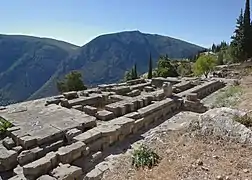
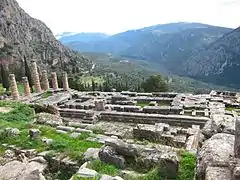
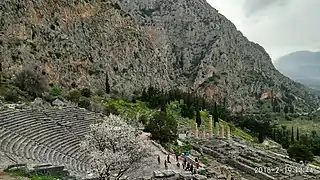

.jpg.webp)
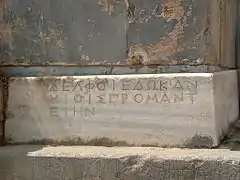
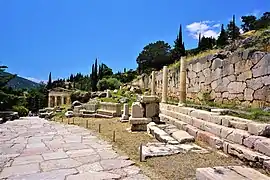
.jpg.webp)
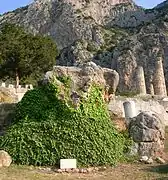
_on_October_4%252C_2020.jpg.webp)
